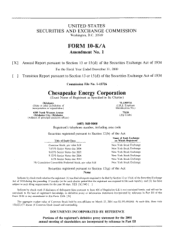Chesapeake Energy 2000 Annual Report Download - page 21
Download and view the complete annual report
Please find page 21 of the 2000 Chesapeake Energy annual report below. You can navigate through the pages in the report by either clicking on the pages listed below, or by using the keyword search tool below to find specific information within the annual report.
Estimates of oil and gas reserves are uncertain and inherently imprecise.
This report contains estimates of our proved reserves and the estimated future net revenues from our
proved reserves, including those acquired in the Gothic acquisition. These estimates are based upon various
assumptions, including assumptions required by the SEC relating to oil and gas prices, drilling and operating
expenses, capital expenditures, taxes and availability of funds. The process of estimating oil and gas reserves is
complex. The process involves significant decisions and assumptions in the evaluation of available geological,
geophysical, engineering and economic data for each reservoir. Therefore, these estimates are inherently
imprecise.
Actual future production, oil and gas prices, revenues, taxes, development expenditures, operating
expenses and quantities of recoverable oil and gas reserves most likely will vary from these estimates. Such
variations may be significant and could materially affect the estimated quantities and present value of our
proved reserves. In addition, we may adjust estimates of proved reserves to reflect production history, results of
exploration and development drilling, prevailing oil and gas prices and other factors, many of which are beyond
our control. Our properties may also be susceptible to hydrocarbon drainage from production by operators on
adjacent properties.
At December 31, 2000, approximately 30% (27% on a pro forma basis for the Gothic acquisition) by
volume of our estimated proved reserves were undeveloped. Recovery of undeveloped reserves requires
significant capital expenditures and successful drilling operations. The estimates of these reserves include the
assumption that we will make significant capital expenditures to develop the reserves, including $216 million
($235 million on a pro forma basis for the Gothic acquisition) in 2001. Although we have prepared estimates
of our oil and gas reserves and the costs associated with these reserves in accordance with industry standards,
we cannot assure you that the estimated costs are accurate, that development will occur as scheduled or that
the results will be as estimated.
You should not assume that the present values referred to in this report represent the current market
value of our estimated oil and gas reserves. In accordance with SEC requirements, the estimates of our present
values are based on prices and costs as of the date of the estimates. The combined December 31, 2000 present
values pro forma for Gothic are based on combined weighted average oil and gas prices of $26.42 per barrel of
oil and $10.13 per mcf of natural gas, compared to our weighted average prices of $24.72 per barrel of oil and
$2.25 per mcf of natural gas used in computing Chesapeake's December 31, 1999 present value. Actual future
prices and costs may be materially higher or lower than the prices and costs as of the date of an estimate. A
change in price of $0.10 per mcf and $1.00 per barrel would result in:
a change in our December 31, 2000 present value of proved reserves of $62 million and
$13 million, respectively; and
a change in the December 31, 2000 present value of proved reserves for us and Gothic combined
of $75 million and $14 million, respectively.
If the present value of our combined pro forma proved reserves were calculated using a more recent
approximation of NYMEX spot prices of $24.00 per barrel of oil and $5.00 per mcf of gas, adjusted for our
price differentials, the present value of our combined pro forma proved reserves at December 31, 2000 would
have been $3.2 billion.
Any changes in consumption by oil and gas purchasers or in governmental regulations or taxation will also
affect actual future net cash flows.
The timing of both the production and the expenses from the development and production of oil and gas
properties will affect both the timing of actual future net cash flows from proved reserves and their present
value. In addition, the 10% discount factor, which is required by the SEC to be used in calculating discounted
future net cash flows for reporting purposes, is not necessarily the most accurate discount factor. The effective
interest rate at various times and the risks associated with our business or the oil and gas industry in general
will affect the accuracy of the 10% discount factor.
-10-
























